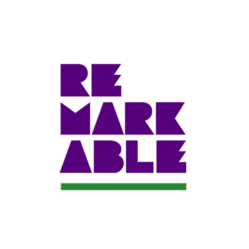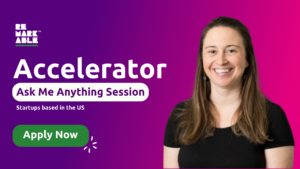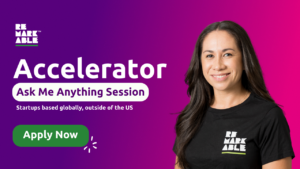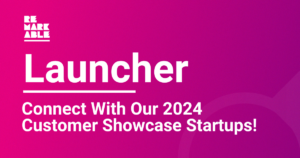
We’re so excited and honoured to welcome activist and model, Angel Dixon as the MC of our #SYD20 Demo Day.
Angel is committed to removing the barriers to participation and opportunity that people with disability encounter. She is passionate about inclusion and authentic representation. Angel is the former CEO of Attitude Foundation and the Advocacy Manager for Starting with Julius. Angel is also an international Fashion Week model and in 2017 became the first adult agency signed model with a physical impairment to be featured in a national television campaign. For her activism in the area of representation, Angel was named the 2019 Queensland Young Australian of the Year.
We asked Angel a few questions about her work and what she is excited about for our #SYD20 Demo Day, check them out below!
—
Could you please tell us about your amazing career and how it led you to become a model and activist?
I find it hard to use the word “career” when discussing the beginnings of my journey because it started as my lifestyle. I was (and still do) spend a significant amount of time and energy when in public advocating for my own rights to equal treatment and access. I owe my “career” to my fellow community members, people with disability who had shared experiences and supported and encouraged me to use my voice and help to create a platform for us all.
I work in a number of different ways to accelerate inclusion and my time is spread between media, fashion, accessibility and research. I find the best mechanisms to create impact and change are media and advertising which is where I spend most of my time, modelling is included in that but I also work in accessibility and research. My goal was never to become a model. It was to disrupt the processes and systems that led to the exclusion and misrepresentation of people with disability. Modelling has been a great area to promote the issue while pumping as many examples of inclusive media and advertising as I possibly can out into the world. I have been lucky enough to collaborate with some incredible Australian and international brands.
My body being included in campaigns and on runways is multifaceted. Representing people with disability as part of the general diversity of our community is new so there are learnings for each brand I work with. They need to think about accessibility and authentic and incidental representation. One of the best side effects of a brand practising inclusive advertising is that their learnings generally extend to other areas of the brand or organisation. It is also extremely important and powerful for people with disability to have role models, there are very few people with disability in public leadership roles or in mainstream areas. I receive messages of thanks and support after every campaign I do.
You’re committed to shaping a new understanding of disability through the promotion of realistic portrayals in the media – how has this journey been and have you seen a positive change occur?
This question is a quote from the Attitude Foundation website where I was CEO until recently – I am now a board member. At Attitude and in all the other projects I work on, I am always striving to shape a new understanding of disability and get new and different conversations going. Thanks to the sheer number of people with disability all over the world who have campaigned for better and increased representation in media, there has been a significant shift in the last few years. There is still a lot of work that needs to be done to ensure sustainability and to make sure that tokenism in the media is truly a thing of the past. To me, tokenism goes beyond stereotypical representation on screen. The elimination of tokenism in the media would mean that stories can be developed, produced and consumed in accessible and inclusive ways.
You also work in the area of universal design, would you mind explaining what this entails?
This is another part of my “career” that started as a lifestyle. I was living in San Francisco and exploring the roots of the Disability Rights Movement when I came across The Ed Roberts Campus. Ed was a pioneer in the rights movement and a promoter of a concept called Universal Design. Learning about the concept and other concepts surrounding inclusion for people with disability was an individual and private quest to solve the exclusion I was personally experiencing but once I discovered the concept, I had to share it!
Universal Design is defined as; “the design of products and environments to be usable by all people, to the greatest extent possible, without the need for adaptation or specialized design.” – The Center for Universal Design at North Carolina State University
Accessibility is still thought of as an option to people who can easily access typically designed environments/technology/education…the list goes on. When in fact, equal access is a human right and it is a right that must be upheld by all of us. Because of a lack of understanding and the mistake of not including people with disability in design processes, our society has developed band-aid fixes for access purposes that often create more confusion. Sometimes I am lucky enough to present at events or work on projects that aim to embed universal design from the start of the design process – that work is some of my favourite.
There is a cartoon that I use often to explain universal design; a bunch of people are at the entrance of a building that has both stairs and a ramp. It has been snowing and there is a person clearing the stairs of snow so people can enter the building. There is a person using a wheelchair in the crowd and they say “could you please clear the ramp”. The person shovelling snow says “I’ll clear the stairs for everyone and then I’ll clear the ramp for you”. The wheelchair user then says “but if you clear the ramp, we can all use it”.
That cartoon is fantastic because it not only explains universal design but it also helps people understand exclusion.
What excites you about the work that we do at Remarkable?
What doesn’t excite me about the work you do!?
People with disability are limited in choice of lifestyle, work, education, etc and unfortunately, educating the world on universal design and changing all our stuff takes time. One of the major problems surrounding product and service design for people with disability (and the reason most band-aid fixes create more harm than good) is that they are created without the input of the user/consumer, people with disability.
The work Remarkable does is important to ensure that the (for now) bandaid fixes and new products or services are actually usable and created with people with disability. Through co-design, education and targeted support, the Remarkable accelerator program also fosters innovative and inclusive ways to approach the future of business.
What are you most looking forward to about our upcoming #SYD20 Demo Day?
I’m excited for this cohort of entrepreneurs to get their work out into the world and for people to learn more about the important work Remarkable is doing! I’ve been involved in the accelerator program as a speaker for the last couple of years and I was honoured to be asked to MC this event. Obviously, to ensure our community is safe and comfortable, this event will be a virtual one and I’m looking forward to seeing everyone experience this new way of getting together.
In five years’ time where you would like to see the future of media and technology?
This is a loaded question and this blog does not have enough space for me to give my full answer. For now, I will say that the current COVID-19 pandemic has done many things to our society. It is a challenging time for everyone but it is particularly challenging for those people that rely on consistency of service provision and accessibility. It’s unfortunate that a global pandemic had to happen for organisations and industries to make significant changes (changes that the Disability Rights Movement have been asking for for years), but COVID – 19 has forced the world into addressing inaccessibility in a number of areas and my greatest hope is that those changes will stick around and be a springboard for more innovation and inclusion in the near future.



